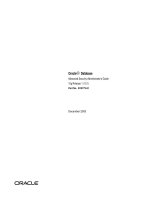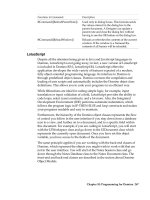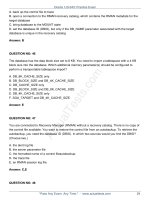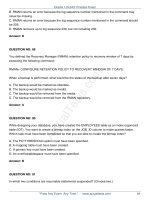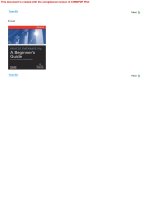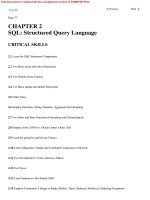Oracle Database 10g A Beginner''''s Guide phần 5 docx
Bạn đang xem bản rút gọn của tài liệu. Xem và tải ngay bản đầy đủ của tài liệu tại đây (1.4 MB, 25 trang )
Team Fly
Page 242
This chapter introduces the key features of Java that an Oracle DBA needs to understand when managing Oracle
Database 10g. Topics include Java features and terminology, configuring Java in the database, connecting to Oracle
using Java, JDBC, and SQLJ, Java-stored procedures, and the direction of Java in Oracle. This chapter may give
some traditional Oracle DBAs a headache but the information in this chapter describes a popular application
environment that Oracle Database 10g will run in, and which some DBAs need to be able to support.
Java Server Fundamentals
Mention Java to an Oracle DBA and you will often see a look of curiosity, disdain, disinterest, or fear. It has been a
subject that most production DBAs have ignored for years. Although a core language since Oracle 8.1.5, most
production DBAs have not placed a lot of emphasis on learning Java. A primary reason is that Java has not impacted
most Oracle DBAs' job responsibilities in older releases of Oracle. However, changes in the industry, markets and
Oracle technology directions no longer provide DBAs with that luxury. Java technology is integrated tightly with the
Oracle Database 10g, Oracle Application Server 10g, Oracle JDeveloper 10g, Oracle Application Server Web
Services, Oracle XML DB, and the Oracle Developer Suite 10g, including Oracle Forms and Reports.
NOTE
Many of the topics discussed in this chapter could, each on their own, take an entire book to cover
completely. Since this is an introductory book, specifics for some topics have been omitted. Real-world
experiences and additional reading will build on this material.
CRITICAL SKILL 7.1
What Does Java Mean to an Oracle DBA?
Java is one of the core languages (SQL, PL/SQL, Java, XML, and HTML) that are tightly integrated in the Oracle
Database 10g suite of products. The Extensible Markup Language (XML) is a hierarchical data structure that
describes data by embedding the metadata with the data structure. Java has become the primary language for new
applications that are written for Oracle databases. Why does an Oracle DBA care about Java? Java in an Oracle
environment impacts architectural decisions, performance, leveraging new technologies, security, and application
development. Java-stored procedures can run in the Oracle database server. So, if Java code can run
Team Fly
This document is created with the unregistered version of CHM2PDF Pilot
Team Fly
Page 245
Oracle Database 10g supports technologies such as Java, XML, HTTP, and Web Services directly in the database
server.
Successful and marketable DBAs in Oracle Database 10g environments need to be able to do more than just
performance tuning, backup/recovery, and storage management.
These technologies provide open standard solutions for integration and communication across heterogeneous,
distributed environments. What's more important is that the industry is supporting these new standards and leveraging
them. These standards, however, are still evolving and changing. Nevertheless, the strong advantages of these
technologies cannot be ignored and large organizations are seriously looking at them.
Traditionally, Web Services has been deployed in the middle-tier. The middle-tier is the level between the client-tier
(presentation-tier) and the information-tier (data-tier or database server-tier) that contains the business logic. The
middle-tier usually contains an application or web server. In Oracle Database 10g, the database server can be a
Web Services provider. Supporting Web Services in the database offers Enterprise Information Integration. With the
proliferation of web-based applications, the integration and connectivity is critical. Web Services can provide the glue
that leverages different technologies and environments. In disconnected environments (Internet), accessing stored
procedures (Java), data, and metadata (XML) through Web Services offers additional options and flexibility.
So what does Java mean to an Oracle DBA? Java is a core language that is integrated in the Oracle Database 10g
server and primary Oracle products such as the application server, Oracle development products, and applications.
Second, Java is a key technology that is integral to technologies that are playing larger roles in database applications
such as Web Services, application servers, XML, and the development of standards-based environments.
CRITICAL SKILL 7.2
Overview of Java
This section will introduce DBAs to the Java programming language from a DBA perspective. After reading this
section, DBAs will also understand enough terms and acronyms to speak with confidence at any barbeque party
where Java developers are in attendance. The emphasis in this section will be on terminology and concepts important
for a new Oracle Database 10g DBA. Here are some of the reasons why Java has become a mainstream language:
Object-Oriented Java is an object-oriented programming (OOP) language that has become quite mainstream. An
object-oriented language uses
Team Fly
This document is created with the unregistered version of CHM2PDF Pilot
Team Fly
Page 254
CRITICAL SKILL 7.3
Configure Java for Oracle
The Oracle JVM must be configured and installed to run Java in Oracle Database 10g. The core Java classes,
including the JDBC (Java Database Connectivity APIs) and SQLJ (embedded SQL for Java) classes are all natively
compiled for performance. Once the Oracle JVM is installed, Java-stored procedures can be executed in the Oracle
database, but they must be configured separately on the middle and client tiers. During the database installation, a
large number of Java classes are loaded into Oracle Database 10g.
This document is created with the unregistered version of CHM2PDF Pilot
Team Fly
Page 256
CRITICAL SKILL 7.4
Java in Oracle
The Java runtime environment contains the JVM, the Java runtime class libraries, JDBC, SQLJ, and a Java
application launcher. Oracle Database 10g is a deployment environment, not a development environment. Java code
should be created in a Java development tool such as Oracle JDeveloper 10g. The appropriate Java files should then
be loaded into the Oracle database.
Once the Oracle JVM option is configured, Java-stored procedures can be executed using JDBC and SQLJ. The
Oracle JVM also uses a PL/SQL package DBMS_JAVA. Be aware that Java names can exceed the SQL identifier
length. The database allows a Java name to be up to 4000 characters in length. If a Java name (long name) exceeds
the maximum SQL identifier name length, then Oracle will also create an alias (short name). The following query will
display long and short names. The long names are abbreviated for display purposes.
Format the query, and display long and short names:
This document is created with the unregistered version of CHM2PDF Pilot
Team Fly
Page 258
CRITICAL SKILL 7.5
JDBC Drivers
Java DataBase Connectivity (JDBC) is a set of APIs that provide SQL capability for Java. JDBC is an
industry-standard set of APIs for database access. There is one industry standard of APIs for JDBC. Each database
vendor provides additional vendor-specific JDBC drivers that support database specific functionality. Oracle
supports three different types of JDBC drivers.
JDBC Thin Driver
A JDBC thin driver is a driver written completely in Java. It is referred to as a thin driver because it does not require
additional vendor-specific networking code. A JDBC thin driver is dynamically loaded at runtime. A thin driver,
which uses TCP/IP, works well with standalone applications and firewalls within an intranet. Oracle networking
software is not required on the client with a thin driver.
JDBC Thick Driver
A JDBC thick (OCI) driver requires additional vendor networking software. Oracle Net Services must be installed
on the client or middle tier to use the JDBC thick driver. Oracle Net Services software uses the JDBC Oracle Call
Interface (OCI) to access the Oracle database. Do not use the thick driver with applets. Java code using the JDBC
thick driver can leverage the feature/functionality of Oracle Net Services such as connection pooling. The thick driver
requires additional resources but performs better than the thin driver.
JDBC Server-Side Driver
A Java program that runs in the Oracle database server uses a server-side (KPRB) driver. This allows these
server-side Java programs to access Oracle data directly without having to go through the network. With these
programs running in the Oracle kernel space, this can offer a significant performance gain for data-intensive
algorithms.
Use the Proper JDBC Driver
The type of JDBC driver to use is defined during database connection. Java applications that are running on a client
can use a thin or thick driver. Thick drivers are used on the middle tier for application servers. Server-side drivers
can only be used inside of the Oracle database. When a Java program tries to connect to the Oracle server, the
JDBC driver needs to be specified. The following examples use a thin and OCI driver, respectively:
This document is created with the unregistered version of CHM2PDF Pilot
Team Fly
Page 259
Java-stored procedures run inside of the Oracle kernel memory. To run a Java-stored procedure, a session must
already be established. The connection inside a Java-stored procedure specifies to use the existing session similar to
how a PL/SQL program runs inside of a current session. The following example tells the Java program to use the
current session. A connection cannot be closed inside of a Java-stored procedure.
This document is created with the unregistered version of CHM2PDF Pilot
Team Fly
Page 260
4. Checking for end of data.
5. Closing the cursor.
When writing Java database programs, a similar set of steps need to be performed:
1. Registering a driver.
2. Connecting to a database.
3. Executing a statement.
4. Fetching data. (The check for end of data is done during the fetch.)
5. Closing the resources.
Project 7-1 Accessing the Database with Java
JDBC is required for accessing databases from within Java. In this project, you will walk through the necessary
JDBC steps for performing a simple query.
Step by Step
1. The first step in connecting to a database requires registering a driver. Oracle offers two different ways of
registering a driver:
This document is created with the unregistered version of CHM2PDF Pilot
Team Fly
Page 261
statement variable and use your previous connection. Then we will send the results of our SQL query into a result set
variable, ready for use.
This document is created with the unregistered version of CHM2PDF Pilot
Team Fly
Page 262
translator (precompiler) is used to convert a .sqlj file containing embedded SQL statements into a .java file containing
JDBC statements. The translated .java file is then compiled. SQLJ statements can contain queries, DML, transaction
control, and DDL statements. The SQLJ translator in the database will automatically convert .sqlj files into compiled
Java code.
Sample SQLJ Code
SQLJ makes it easier for traditional Oracle developers to write Java database code. Oracle developers can embed
the SQL statements without having to work with all of the JDBC interfaces. SQLJ performs compile time checking of
SQL statements while JDBC performs runtime checking of SQL statements. The following code snippets are some
examples of using SQLJ.
This document is created with the unregistered version of CHM2PDF Pilot
Team Fly
Page 264
Privileges
To load Java classes, the create procedure and create table minimum privileges are required. Java classes are
schema objects just like PL/SQL procedures or tables. Java files are stored in Java ARchive (JAR) files. A JAR file
is a specialized type of Zip file. The following related Java files can be found in a JAR file: .java, .class, .properties,
.sqlj, or .ser files.
Java classes can be loaded or created individually, or the loadjava tool can be used. The loadjava utility is similar to
the SQL*Loader tool. loadjava loads Java files while SQL*Loader loads data. By default, Java-stored procedures
run under invoker's rights.
Resolver Specifications
Programs often need to access additional programs. Typically, a search path is defined where the programs should
look for additional files. Operating systems organize files in directories, while Oracle organizes database objects in
schema. A Java class, on the other hand, is loaded into a schema. If a Java class needs additional classes, a search
path needs to be defined. To do this, a resolver specification (spec) can be used, which defines where additional
classes can be found. In other words, a resolver spec is a search path in Oracle of schemas to find Java classes.
The default resolver will automatically look in the current schema and then in PUBLIC, which is where the core Java
class libraries are located. Resolvers can also be defined to specify additional schemas.
Project 7-2 Creating a Java-Stored Procedure
This project will take a DBA through the basic steps of creating a Java-stored procedure. Java programs can have a
main () method. This is an entry point for a Java application. Java-stored procedures will be initiated from another
application so they do not need a main () method.
Step by Step
1. Create a simple class named MyFirstProgram.java:
This document is created with the unregistered version of CHM2PDF Pilot
Team Fly
Page 266
Project Summary
This project walked you through the steps a DBA will take to create and test a Java-stored procedure.
CRITICAL SKILL 7.9
Create Java Objects in Oracle
loadjava is one way of creating Java classes in the database. It is a preferred method since it can leverage Java
development environments and then load the generated Java class and JAR files. The DDL statements described in
the following sections can also be used to create Java classes or related files.
create java class
The create java class command can be used to load a Java class file from the operating system. An Oracle
directory object must be created so the class file can be found on the operating system. The following statement can
be used to load an individual Java class into Oracle:
This document is created with the unregistered version of CHM2PDF Pilot
Team Fly
Page 267
This document is created with the unregistered version of CHM2PDF Pilot
Team Fly
Page 271
CHAPTER 8
XML
CRITICAL SKILLS
8.1 Understand XML
8.2 Oracle XML DB: Use XML in the Database
8.3 SQLX: Create XML from Data Stored in Oracle
8.4 Store XML in Oracle XML DB
8.5 Use Simple Queries
8.6 Create a Relational View from XML
8.7 Learn Programmatic Access Using XSLT
Team Fly
This document is created with the unregistered version of CHM2PDF Pilot
Team Fly
Page 272
Before we begin to see how Extensible Markup Language (XML) and Oracle Database 10g work together, we
need to look at why XML is important for us and why Oracle has included significant support for XML in the Oracle
XML DB. This chapter will discuss what XML is and why it is important to our computer futures. Additionally, we
will show you how Oracle can become an integral part of all of your solutions that need to use XML.
CRITICAL SKILL 8.1
Understand XML
Most of you have visited countless web sites, have navigated to the menu bar at the top of a browser screen, and
then selected View Source. At this point, guess what you are looking at html or hypertext markup language. As
html became more and more popular, the most brilliant minds decided to extend the power of the language. They
were specifically interested in designing a way to enhance HTML's functionality with a set of user-defined tags. A tag
is simply a keyword bound by greater-than signs, less-than signs, and a specially placed forward slash. The following
listing shows a few sample tags in html; the tags themselves are bolded.
This document is created with the unregistered version of CHM2PDF Pilot
Team Fly
Page 273
NOTE
As you may have noticed, we have glossed over the discussion of XML it is a very big topic demanding its
own phone book sized volume. We will attend to Oracle XML DB specifics in the rest of this chapter, and
leave you to discover the big picture of XML on your own.
CRITICAL SKILL 8.2
Oracle XML DB: Use XML in the Database
XML is quickly being adopted as the data transport mechanism on the information highway it is a W3C-endorsed
standard markup language for documents. W3C stands for World Wide Web Consortium, an organization of
approximately 400 members. They represent both public and private sectors, whose goal is to develop interoperable
technologies (specifications, guidelines, software, and tools) for the World Wide Web. The following is an example
XML document, leveraging the power of custom tags:
This document is created with the unregistered version of CHM2PDF Pilot
Team Fly
Page 276
CRITICAL SKILL 8.3
SQLX: Create XML from Data Stored in Oracle
For years, organizations have been pouring their data into relational databases. If you're trading data with another
organization, however, it's likely that you'll need to pull data out of your relational database and format that data as
XML before transmitting it.
Let's first point out that generating XML from a relational source is a not a trivial task. It involves understanding how
to map relational data into a hierarchal structure. On the other hand, creating the XML once you understand the
mapping you want has been made easy.
The SQL/XML Standard
Oracle Database 10g implements a number of standards-based functions enabling you to query relational data and
return XML documents. These functions collectively fall under the heading of SQL/XML, sometimes referred to as
SQLX. SQL/XML is part of the ANSI/ISO SQL standard.
The international standard for SQL/XML defines the following elements:
XML A data type to hold XML data
XMLAgg A function to group, or aggregate, XML data in group by queries
XMLAttributes A function used to place attributes in XML elements returned by SQL queries
XMLConcat A function to concatenate two or more XML values
XMLElement A function to transform a relational value into an XML element, in the form: elementName value /
elementName
XMLForest A function to generate a list, called a ''forest," of XML elements from a list of relational values
XMLNamespaces A function to declare namespaces in an XML element
XMLSerialize A function to serialize an XML value as a character string
Oracle Database 10g has implemented the following XML data type (as XMLType), XMLAgg, XMLConcat,
This document is created with the unregistered version of CHM2PDF Pilot
XMLElement, and XMLForest. Support for the other functions is planned in future releases. In addition to the
functions and the data type, the SQL/XML standard defines rules for transforming column names into XML element
names and for transforming SQL data types into XML data types. These rules are applied automatically by
XMLElement and the other SQL/XML functions. Let's look at four of many SQLX functions that are commonly
used to produce XML from the relational database.
Team Fly
This document is created with the unregistered version of CHM2PDF Pilot
Team Fly
Page 281
The following is the expected result (partial) of our SQL query:
This document is created with the unregistered version of CHM2PDF Pilot
Team Fly
Page 283
3. When can the xmlattributes() function be called?
4. What corresponding SQL clause must accompany an xmlagg() function?
CRITICAL SKILL 8.4
Store XML in Oracle XML DB
Databases are relational and XML is hierarchical, so prior to the introduction of Oracle XML DB there had been no
simple, elegant way to integrate the two. Traditionally, developers have had two choices: either use a parser to
deconstruct the document data into relational data and store it as such in the database, or store the entire document
as a text file, preserving its text-based structure. Oracle XML DB starts it all off by first solving the problem of
representing an XML document in its native format the XMLType.
The Native XMLType
The XMLType was created to be able to preserve the XML paradigm while getting the benefits of relational
performance and scalability. It is a native server data type that allows the database to understand that a column or
table contains XML in the same way that the DATE data type allows the database to understand that a column
contains a date. The twist is that the XMLType also provides methods that allow common operations such as
schema validation and XSL transformations to be performed on XML content.
The XMLType data type can be used just like any other data type, such as when creating a column in a relational
table, when declaring PL/SQL variables, and when defining and calling PL/SQL procedures and functions. Since
XMLType is an object type, it is also possible to create a table of XMLType. The following listing shows how to
create a simple table with an XMLType column:
This document is created with the unregistered version of CHM2PDF Pilot
Team Fly
Page 287
This document is created with the unregistered version of CHM2PDF Pilot
Team Fly
Page 291
This document is created with the unregistered version of CHM2PDF Pilot
Team Fly
Page 293
Project 8-3 Using Simple Queries
In this project, we will be querying for a specific XML document and then updating it.
Step by Step
1. Log into SQL*Plus.
2. At the SQL prompt, enter the long command, set long 10000, and then press ENTER.
3. At the SQL prompt, enter the long command, set pagesize 80, and then press ENTER.
4. Enter the following SQL query:
This document is created with the unregistered version of CHM2PDF Pilot
Team Fly
Page 294
Project Summary
This project illustrated the use of existsnode(), extract(), and extractvalue() when identifying an XML document
stored in the Oracle Database 10g.
In the future, Oracle is looking at adding several new capabilities to this list, including additional database and XML
functionalities, such as XQuery, which will be a language specifically designed to query XML data from a document
perspective rather than the rows-and-tables perspective of SQL. We have had fun finding and returning XML
documents. Let's proceed and look at how we can take XML documents and represent them relationally.
Progress Check
1. Is the Oracle XML DB repository separate from the Oracle Database 10g?
2. Why must we ''register" the URL of XML Schemas into the Oracle XML DB repository?
3. How do we load an XML document into the Oracle XML DB repository?
4. What is the difference between the existsnode() function and the extract() function?
CRITICAL SKILL 8.6
Create a Relational View from XML
Oracle XML DB makes it possible to expose XML content, stored in the database through conventional relational
views. This means that tools, applications, and programmers who have no understanding of XML, but understand the
Oracle Database 10g, can now work with XML content. To accomplish this, the view
Progress Check Answers
1. No, the Oracle XML DB is integrated with Oracle Database 10g.
2. The XML Schema defines the legal structure for an XML document. To confirm that the XML
stored within the XMLType is "valid," the URL for the XML Schema it is associated with must be
registered.
3. XML documents can be loaded into the Oracle XML DB via programs using SQL, PL/SQL,
and Java or by going through the protocols FTP, HTTP, and WebDAV.
This document is created with the unregistered version of CHM2PDF Pilot
4. The existsnode() function identifies the existence of a node returning a Boolean value, while the
extract() function extracts the node or set of nodes identified, returning a single text node.
Team Fly
This document is created with the unregistered version of CHM2PDF Pilot
Team Fly
Page 296
CRITICAL SKILL 8.7
Learn Programmatic Access Using XSLT
Data encapsulated in XML can be used in a number of ways. One common means of manipulating it is through the
use of Extensible Stylesheet Language Transformations (XSLT), which enable developers to define operations that
must be performed on an XML document to produce a specific result. This ability to transform information on the fly
makes it possible to use a single source for multiple outputs such as HTML, whether those outputs lead to different
databases or to different browsers. XML documents have structure but no format.
Oracle XML DB uses the template rules and other formatting elements that appear within the XSLT style sheets. It
includes an XSLT-based transformation engine to automatically transform XML-tagged documents into multiple
display formats, store the transformed renditions generated by the XSLT style sheets, and deliver content in the
appropriate formats to various devices.
The following example shows how transform() can apply XSLT to an XSL style sheet, PurchaseOrder.xsl, to
transform the PurchaseOrder.xml document:
This document is created with the unregistered version of CHM2PDF Pilot
